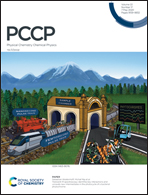Selective host–guest chemistry, self-assembly and conformational preferences of m-xylene macrocycles probed by ion-mobility spectrometry mass spectrometry†
Abstract
We demonstrated ion-mobility spectrometry mass spectrometry (IMS-MS) as a powerful tool for interrogating and preserving selective chemistry including non-covalent and host–guest complexes of m-xylene macrocycles formed in solution. The technique readily revealed the unique favorability of a thiourea-containing macrocycle MXT to Zn2+ to form a dimer complex with the cation in an off-axis sandwich structure having the Zn–S bonds in a tetrahedral coordination environment. Replacing thiourea with urea generates MXU which formed high-order oligomerization with weak binding interactions to neutral DMSO guests detected at every oligomer size. The self-assembly pathway observed for this macrocycle is consistent with the crystalline assembly. Further transformation of urea into squaramide produces MXS, a rare receptor for probing sulfate in solution. Tight complexes were observed for both monomeric and dimeric of MXS in which HSO4− bound stronger than SO42− to the host. The position of HSO4− at the binding cavity is a 180° inversion of the reported crystallographic SO42−. The MXS dimer formed a prism-like shape with HSO4− exhibiting strong contacts with the 8 amine protons of two MXS macrocycles. By eliminating intermolecular interferences, we detected the low energy structures of MXS with collisional cross section (CCS) matching cis–trans and cis–cis squaramides-amines, both were not observed in crystallization trials. The experiments collectively unravel multiple facets of macrocycle chemistry including conformational flexibility, self-assembly and ligand binding; all in one analysis. Our findings illustrate an inexpensive and widely applicable approach to investigate weak but important interactions that define the shape and binding of macrocycles.



 Please wait while we load your content...
Please wait while we load your content...